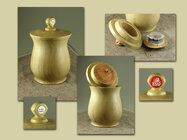Advice I wish I got early on but finally learned:
1. learn to sharpen and do it often
2. find a mentor and learn
3. learn the line of fire and stay out of it.
4. be sure you need a tool before you buy it.
5. Join a local club and attend meetings
6. Read, watch videos, but mostly turn.
7. learn safety rules and follow them—respiratory and face protection.
8. Research and ideally test drive lathes before a purchase.
9. Take classes from experienced turners.
10. Don’t turn when you are tired.
11. Join and support AAW.
Add to the list.
The best one I ever heard, I think, and these are all great, was this:
"Safety is a CHOICE! You choose to be safe, or not. Every time you compromise your safety, you ARE BEING UNSAFE. Make the right choice."
I run this through my head every time I use one of my cutting machines in particular, my router, etc. Particularly high speed/high RPM things, this runs through my head all the time. I had to actively burn it in, so I actively made myself think of it at first, but now its automatic. I think this is one of the most important things. Thinking this, makes you not only be safe with the obvious stuff, but over time, it makes you REALIZE when you might in fact be doing something unsafe, and you start recognizing just how many STUPID things we can do as woodworkers that...might lop off a finger, or mangle a hand, konk you on the head, etc. It applies to more benign things too...E.G. wearing PPE, all the time! (I can speak all too well, to the real consequences of NOT wearing appropriate PPE, and the kinds of respiratory, nasal and other issues that can arise as a result of insufficient protection!)
I made this my Rule #1. The rest come after it.
I'll also throw my backing against #1 in the list above. Sharp tools, are so important! I've gone through phases, where I have just kind of gotten fed up with sharpening all the time, and the end results are always worse than when I sharpen often and really sharpen well. Projects also go faster when you have good sharp cutting tools...cutting wood well, is fast. Cutting wood poorly, is actually quite SLOW!!
Also think that #8 is really important too. I've owned four lathes at this point. Overall, grand total spent, is about $8000!! (More when you account for shipping.) I ended up selling one for a bit less than $2000 (recovered most of my original cost.) For that kind of money, I could have just bought a Robust outright, and been done with it!

I now own a Powermatic 3524C, and it is the first time I've had a lathe that has had zero problems, works optimally every time I use it, and is machined to very tight tolerances (i.e the quill is perfect, even at full extension, which is actually really important!) If you can, test out lathes with friends, or at clubs, rent time at Woodcraft, something like that. Maybe more than once. Make sure you know how each of the key features of the lathe works, because sometimes it takes a little use, to identify a problem (in my case, I found out I REALLY HATE Laguna's "Precise Point" technology, and wish I'd never wasted my time with the Revo I purchased...and wished instead I'd gone strait to the Powermatic!)

